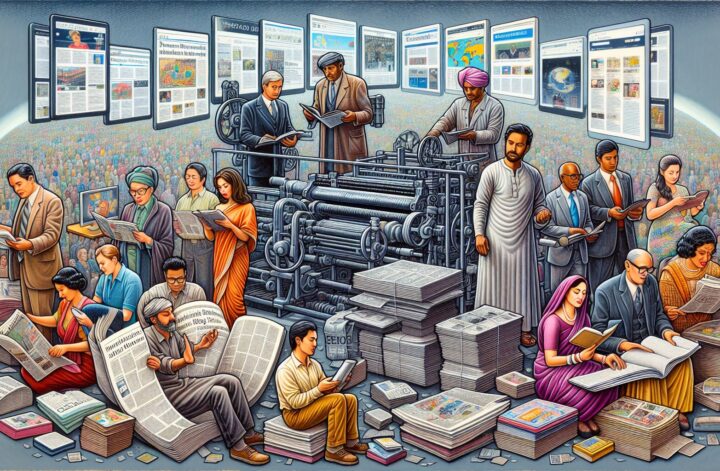In our increasingly digitalized society, it may seem like printing materials have become obsolete. However, the truth is that printed materials still play a vital role in various aspects of our lives. From educational resources to marketing materials, the power of print remains unparalleled. In this article, we will explore the significance of printing materials, the different types available, and how they continue to shape our world.
The Power of Printing Materials
Printing materials have been an essential part of human communication for hundreds of years. The advent of the printing press revolutionized the way information was disseminated, giving rise to mass literacy and the spread of knowledge. While digital platforms have emerged as convenient alternatives, printed materials still offer unique advantages that cannot be replicated.
Tangibility and Permanence
One of the key advantages of printed materials is their tangibility. Physical documents can be held, felt, and experienced in a way that digital files cannot. The ability to physically interact with a document engages multiple senses and enhances the overall reading experience. Moreover, printed materials also have a sense of permanence. Once printed, they can be kept for years, passed down through generations, and ultimately have a longer lifespan than electronic files that can easily be lost or corrupted.
Credibility and Trustworthiness
Printed materials often carry a sense of credibility and trustworthiness. This is especially true for newspapers, books, and academic journals. In an era of “fake news” and digital misinformation, printed materials offer a level of assurance that the information contained within them has undergone a rigorous vetting process. The publishing industry, with its editorial standards and fact-checking procedures, helps to establish trust and credibility in printed materials.
Accessibility
Despite the growth of digital platforms, access to technology remains unevenly distributed. Not everyone has a reliable internet connection or a digital device at their disposal. This makes printed materials an essential means of communication, particularly in areas with limited technological infrastructure. Printing materials ensures that information can be disseminated to all segments of society, regardless of their access to digital resources.
Different Types of Printing Materials
Printing materials come in a wide variety of forms, each serving a specific purpose. Some of the most common types include:
Books
Books are perhaps the most well-known and widely used printed materials. They serve as repositories of knowledge, entertainment, and inspiration. Whether it’s a novel, a textbook, or a self-help guide, books continue to be cherished for their ability to provide immersive reading experiences and allow us to disconnect from the digital world.
Newspapers and Magazines
Newspapers and magazines are print media staples that have long provided news, current affairs, and feature articles to the masses. While online news outlets have seen a surge in popularity, the unique appeal of physically flipping through the pages of a newspaper or magazine cannot be replicated digitally.
Flyers and Brochures
Printed marketing materials, such as flyers and brochures, remain vital tools for businesses. They help promote products, services, and events to a wide audience. The tactile nature of these materials allows potential customers to engage with the content directly, thus increasing their effectiveness as marketing tools.
Posters and Banners
Posters and banners are commonly used for advertising, both indoors and outdoors. Their larger size and eye-catching designs make them effective in capturing attention and conveying messages in a concise manner. Whether displayed on a street corner or inside a shopping mall, posters and banners remain powerful visual communication tools.
Business Cards
Despite living in the digital age, business cards remain a staple of professional networking. They provide a tangible reminder of a conversation and serve as a physical representation of one’s professional identity. The act of exchanging business cards fosters a personal connection that cannot be replicated by simply exchanging contact information digitally.
The Future of Printing Materials
With the rise of digital platforms, it’s only natural to wonder about the future of printing materials. However, rather than fading into obscurity, printing materials have evolved to complement the digital landscape.
Innovation in Print Technology
The printing industry has witnessed significant advancements in technology, leading to improvements in quality, speed, and cost-effectiveness. Digital printing technology has made it easier for businesses and individuals alike to print materials in smaller quantities, reducing waste and enabling more personalized communication. Additionally, advancements in eco-friendly printing practices have made the production process more sustainable.
Augmented Reality Integration
One exciting development in the printing world is the integration of augmented reality (AR). By combining printed materials with AR technology, users can experience an interactive and immersive digital layer on top of the physical document. This revolutionary integration opens up possibilities for enhanced user engagement, dynamic content updates, and interactive learning experiences.
Customization and Personalization
Printing materials now offer more customization options than ever before. From personalized photo books to custom-designed wedding invitations, the ability to tailor printed materials to specific preferences adds a personal touch that digital media often fails to provide. Customized printing allows individuals and businesses to create unique and memorable experiences for their audiences.
Conclusion
While digital media continues to shape the way information is shared in our modern world, printed materials retain their significance and unique advantages. The tangibility, credibility, and accessibility offered by physical documents cannot be replaced by digital files alone. With innovative print technologies, the integration of augmented reality, and the ability to customize and personalize, printing materials continue to thrive in an increasingly digital society. As we move forward, it’s essential to recognize the complementary nature of print and digital mediums, harnessing the benefits of both to enhance communication and create impactful experiences.



